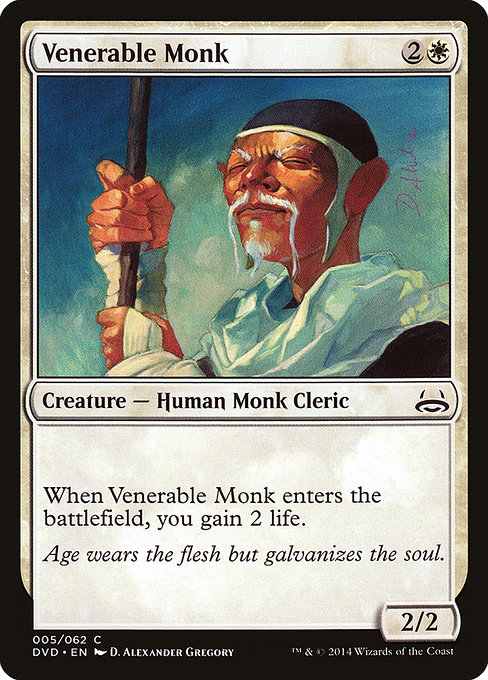
Image courtesy of Scryfall.com
Monte Carlo Simulation for Venerable Monk Triggers
Probability-based triggers are where MTG’s stacks and laughs intersect with cold, hard math. For a card like Venerable Monk, which has a clean, dependable ETB (enter the battlefield) effect—“When this creature enters, you gain 2 life”—a Monte Carlo approach can reveal just how much lifegain to expect across a game, given different draw orders, lands in play, and timing of enters. In practice, this turns a hypothetical about “how often will it trigger?” into a distribution you can actually feel with a little light statistical flair. 🧙♂️🔥
“Magic is a game of uncertain futures; probability is just a way to read the tea leaves on the stack.”
The card at a glance
- Name: Venerable Monk
- Mana cost: {2}{W}
- Type: Creature — Human Monk Cleric
- Power/Toughness: 2/2
- Colors: White
- Rarity: Common
- Set: Duel Decks Anthology: Divine vs. Demonic (DVD)
- Oracle text: When this creature enters, you gain 2 life.
- Flavor text: “Age wears the flesh but galvanizes the soul.”
In the world of probabilities, that simple ETB line becomes a workhorse. Each time Venerable Monk joins the battlefield, the life total increases by a predictable 2 points. The randomness comes from how often the Monk itself hits play across a game and how often you repeat the entering event—whether you’re dropping multiple Monks in a big combo or just relying on a single, steady arrival. The simplicity of the effect makes it an ideal candidate to illustrate Monte Carlo methods: many trials, each simulating a game segment, then averaged to reveal the expected lifegain and the spread around it. 🎲
Constructing the Monte Carlo model
To simulate Venerable Monk triggers, you build a lightweight model around a few core assumptions. First, you decide the number of opportunities (turns or game segments) in which the Monk could enter. You then assign a probability p that the Monk enters on any given opportunity, reflecting your deck’s density of white cards, the rate of ramp, and how aggressively you’re casting on-curve. In each trial, you roll the dice for each opportunity: if the Monk enters, you add 2 life to the running total. After N opportunities, you record the total life gain for that trial. Repeating this, say, 10,000 times gives you a robust distribution for expected lifegain and the variance around it.
There are real-world knobs to tune: p can be a function of game state (fewer lands early, more reliable hits later), and you can model multiple Monks per game if you want to explore the lifegain curve under a mogul of ETBs—perhaps in a creature-heavy stall deck vs. a fast eight-turn finish. You might also broaden the model to incorporate other lifegain sources like Soul Warden or Martyr of Sands, but the baseline remains elegantly simple: each ETB yields a fixed 2 life, and Monte Carlo reveals the distribution of that total over your simulated horizon. 💎
Why this matters in practice
For players, Monte Carlo simulations aren’t just a math toy—they’re a lens for deck-building intuition. If you’re prototyping a white lifegain-led shell or a midrange aggro-control blend, you’ll want to know how resilient your life total is to fluctuation. A single Venerable Monk hitting the battlefield reliably yields a steady trickle of life, but if you’re stacking multiple ETBs or sequencing with lifelink, the cumulative effect can become a feast or famine moment. A well-tuned simulation helps you estimate expected life totals at various game milestones and guides decisions like when to pivot into a more tempo-oriented plan or lean into a stronger lifegain engine. ⚔️
From a design perspective, Venerable Monk demonstrates how a small, clean effect can scale meaningfully when repeated. Its leaf-green simplicity—two mana, a 2/2 body, and a guaranteed 2 life on entry—makes the math approachable while leaving room for dramatic playlines if you combine it with other ETB triggers or synergy cards. This is the kind of card that happily feeds into both nostalgic memory and modern analysis; it’s a gentle reminder that not all value has to be flashy to be deeply impactful. 🎨
When you translate MTG into a probabilistic mindset, you begin to notice the rhythm of the game differently. The Monte Carlo approach doesn’t replace intuition; it augments it with data-backed expectations. If you’re a lover of the stack and the subtle dance of probabilities, Venerable Monk is a delightful case study: modest in power, rich in analytical potential, and perfectly poised for creative lifegain storytelling. 🧙♂️🔥
As you iterate on builds or run your own house rules, keep the math honest. It’s not about predicting a perfect win every game; it’s about understanding the likelihood of meaningful lifegain events across a spectrum of scenarios. The truth often lies in the quiet moments—those two life points that tip a race or smooth out a perilous swing. In the end, Monte Carlo reveals the quiet poetry of probability in a world where even a humble 2/2 monk can change the odds. 💎
And if you’re ever shuffling with a little style between rounds, a practical gadget like the Neon Card Holder Phone Case MagSafe can keep your deck at the ready and your keys close at hand—because good data and good gear both deserve a little flair. 🧙♂️
Neon Card Holder Phone Case MagSafe